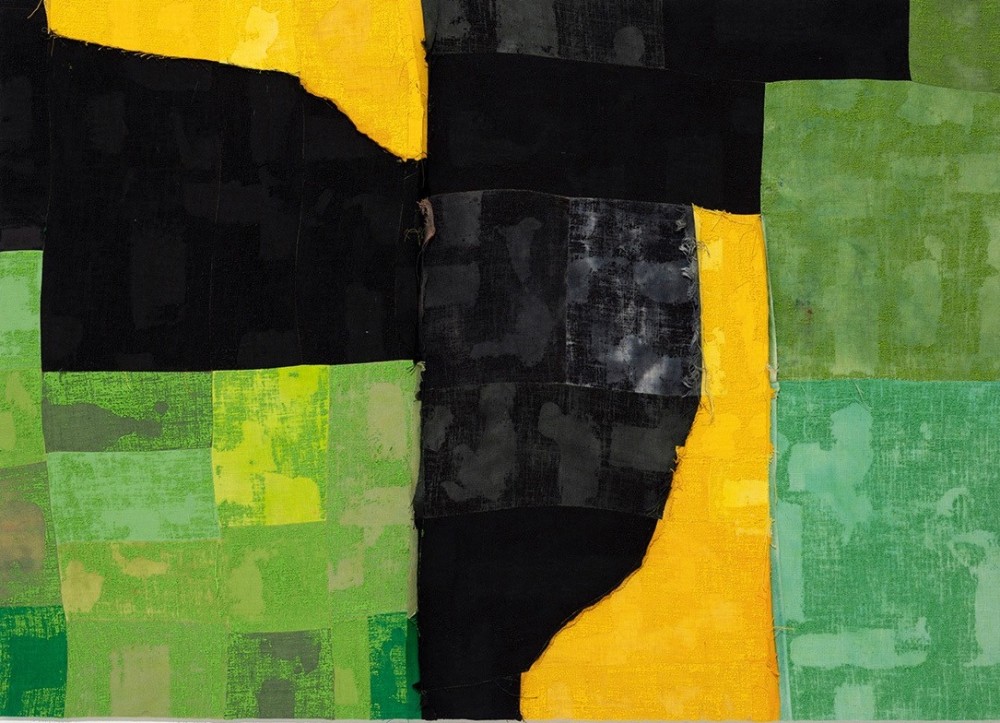
Evan Nesbit /ˈsɪn.kə.sɨs/
Evan Nesbit’s newest exhibition of paintings entitled “/ˈsɪn.kə.sɨs/” on view at Roberts Projects, constitutes an exercise in precision and restraint, utilizing modernist systems of understanding, and recodifying this understanding through an intensely realized and deliberately implemented lyricism. On the surface, this might appear to be a daunting task, however, Nesbit employs restraint as a challenge, a liminal provocation to expand the painterly surface as a phenomenological object, rather than a static irrepressible expression of personal ideation. These paintings derive from an “in body, proprioceptive sensibility” that has no literal beginning and no predetermined end. This haptic awareness extends to all points across the painting’s surface, wherein the movement of the paint is dislocated and reanimated according to a Frankensteinian sensibility.
Nesbit approaches the act of making a painting as a kind of alchemical activity – much like an apothecary might experiment with potions in a dimly lit chamber in the 1400s, not necessarily seeking scientific cure as much as an amplified living experience. Rooted and inspired by the canon of non- objective painting and conceptual abstraction, Nesbit creates new iterations, specifically, a fluidity of repeating glyphs that reference the work of artists like Günther Förg, Ad Reinhardt and Bernard Piffaretti, where the artist limits the parameters of technique, color, and form, opting to find expression of an idea about painting through a "picture making system" that conceptualizes a painting and the artist's chosen affinities diagrammatically. In Nesbit’s case, this is expressed at the onset in drawings, a single glyph acts as a starting point, generating permutations of embrocating composition and color out from an initial signal. The paintings are cobbled together through different processes, their constituent parts sutured together into reanimated furrows of materiality. Each painting is based on a reductive composition and a specific color palette to further comprehend the complexity and relationship of one color to the other. Nesbit’s chosen material, burlap, acts as a physically complex and tactile kind of portal or interface through which the artist then disseminates paint, creating a charged and atavistic kind of absence.
Nesbit employs this same kind of ascetic approach to laying down paint. Hand dying each piece of burlap a specific shade—be it green, yellow, or black—these paintings begin to suggest ostensible relationships between shades and the placement of the colors. Perhaps this is an exercise in entropy wherein the artist seeks a gradual and beautiful decline into disorder, but which also begs the question: at what point in the cycle from simplicity towards entropy do these images aggregate to constitute a new whole, or does repeated synchysis just produce further distortions of the original intended signal?
Either way, Nesbit is attempting to represent a particular “nowness,” a painterly document that embodies transition and observational creativity where the forms set their own inherent parameters, and the artist responds to their mutability.
The word “Synchysis” embodies a rhetorical technique wherein words are intentionally scattered to create a sense of disjunction and bewilderment, or even anarchy within the poetical phrase itself. Writers, especially the Latin poets, long employed this rhetorical device as a means of further obscuring metaphorical meaning. The form is often employed in relation to the “physiology of vision,” however, Nesbit interprets this archaic technique symbolically, deliberately rearranging the structure of a painting, as one might a sentence, so that the subject and its modifiers (the support structure and the paint itself) are separated, and/or, dislocated. This process involves an intentional mixing or rearranging of the literal structure to obscure its intended meaning or to add poetic resonance through a sensation of fluctuating dislocation. It destabilizes our comprehension and consideration of the painting’s original intended meaning.
The stitched seams become a grounding device, a means by which the artist employs his own version of the aesthetics of the sublime, or as Clyfford Still once put it, “paintings are fragments of a means to freedom,” and dedicates them “to all who would know the meaning and responsibilities of freedom.” The painting must be equal to its ethical task, and how it accomplishes it, if it does at all. Nesbit knows this and regards the act of painting as at odds with any system of literal association and evaluation. These are not paintings one looks at to formulate a clearer relationship to self, nor do they ask to be loved. Nesbit asks only that we come to them with eyes wide open. Inevitably, these paintings embody a patchwork type quality of world-weary bewilderment. As with Mary Shelly’s Frankenstein, they long for connection, yet inherent in their make-up is a deep confusion at being alive at all.
/ˈsɪn.kə.sɨs/ marks the artist’s fourth solo exhibition with Roberts Projects. About the Artist
Evan Nesbit’s (b. 1985; based in Nevada City, CA) paintings expand his process of rendering space and depth through illusionistic visual cues, forming works inserted between the boundaries of experience and reality. Nesbit uses pattern, color and material relationships to challenge the pictorial space of painting's modes of perception. For the artist, painting is an attempt through material and process to capture space and light in estranged recognition.
Nesbit received his MFA from Yale University, New Haven, CT and an BFA from San Francisco Art Institute, San Francisco, CA. In 2012, he received the Ely Harwood Schless Memorial Fund Prize from Yale University. Nesbit has had solo exhibitions at Van Doren Waxter, New York; Koki Arts, Tokyo, Weiss, Berlin; James Harris Gallery, Seattle; Annarumma, Naples, Italy; and his work has been presented in group exhibitions at Sargent’s Daughters, New York; Sean Kelly, New York; Praz-Delavallade, Paris; and 18 Projects, Berlin, among others. His work is included in numerous public collections: Crocker Art Museum, Sacramento, CA; Long Beach Museum of Art, Long Beach, CA; Orange County Museum of Art, Costa Mesa, CA; The Pizzuti Collection of the Columbus Museum of Art, Columbus, OH; Fredrick R. Weisman Art Foundation, Los Angeles, CA, among others.